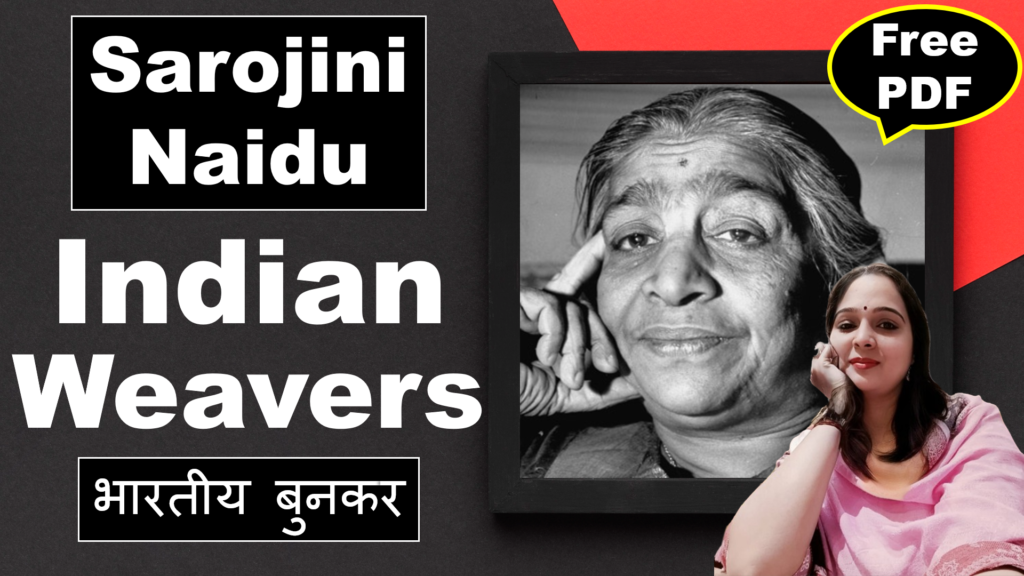
Indian Weavers by Sarojini Naidu | Indian Weavers | Sarojini Naidu | Explanation | Summary | Key Points | Word Meaning | Critical Appreciation | Questions Answers | Free PDF Download – Easy Literary Lessons
Indian Weavers
WEAVERS, weaving at break of day,
Why do you weave a garment so gay? . . .
Blue as the wing of a halcyon wild,
We weave the robes of a new-born child.
Weavers, weaving at fall of night,
Why do you weave a garment so bright? . . .
Like the plumes of a peacock, purple and green,
We weave the marriage-veils of a queen.
Weavers, weaving solemn and still,
What do you weave in the moonlight chill? . . .
White as a feather and white as a cloud,
We weave a dead man’s funeral shroud.
Indian Weavers poem Analysis
Line 1: WEAVERS, weaving at break of day,
Explanation: The poem begins with a description of weavers working at the break of day. The image of weavers working early in the morning suggests their dedication and hard work.
Line 2: Why do you weave a garment so gay? . . .
Explanation: The speaker asks the weavers why they are weaving such a bright and colorful garment. The question suggests that the speaker is intrigued by the garment and the weavers’ work.
Line 3: Blue as the wing of a halcyon wild,
Explanation: The speaker compares the color of the garment to the wing of a halcyon wild, which is a type of bird with bright blue plumage. The comparison suggests that the garment is very beautiful and vibrant.
Line 4: We weave the robes of a new-born child.
Explanation: The weavers reveal that they are weaving the garment for a new-born child. The revelation suggests that the garment is a symbol of new life and beginnings.
Line 5: Weavers, weaving at fall of night,
Explanation: The speaker then describes the weavers working at the fall of night. The image of weavers working late into the night suggests their hard work and dedication.
Line 6: Why do you weave a garment so bright? . . .
Explanation: The speaker asks the weavers why they are weaving such a bright and dazzling garment. The question suggests that the speaker is impressed by the garment and the weavers’ skill.
Line 7: Like the plumes of a peacock, purple and green,
Explanation: The speaker compares the color of the garment to the plumes of a peacock, which is a bird with brightly colored plumage. The comparison suggests that the garment is very beautiful and eye-catching.
Line 8: We weave the marriage-veils of a queen.
Explanation: The weavers reveal that they are weaving the garment for a queen’s wedding veil. The revelation suggests that the garment is a symbol of love and celebration.
Line 9: Weavers, weaving solemn and still,
Explanation: The speaker then describes the weavers working solemnly and quietly. The image of weavers working in silence suggests that they are focused on their work and that they are aware of the importance of the garment they are weaving.
Line 10: What do you weave in the moonlight chill? . . .
Explanation: The speaker asks the weavers what they are weaving in the moonlight chill. The question suggests that the speaker is curious about the garment they are weaving and the purpose it will serve.
Line 11: White as a feather and white as a cloud,
Explanation: The weavers reveal that they are weaving a white garment, as white as a feather and as white as a cloud. The revelation suggests that the garment is a symbol of death and mourning.
The poet’s use of the simile “white as a feather and white as a cloud” is significant. Feathers and clouds are often associated with lightness and airiness. However, in the context of this poem, the simile suggests that the white garment is associated with the lightness and airiness of death.
Line 12: We weave a dead man’s funeral shroud.
Explanation: The weavers reveal that they are weaving a dead man’s funeral shroud. The shroud is white, which is a color associated with death and mourning. The revelation suggests that the garment is a symbol of the finality of death.
The final two lines of the poem are a powerful and poignant reminder of the cycle of life and death. The weavers weave garments for all stages of life, from birth to death. Their work is a reminder that all life is precious and that death is a natural part of life.





